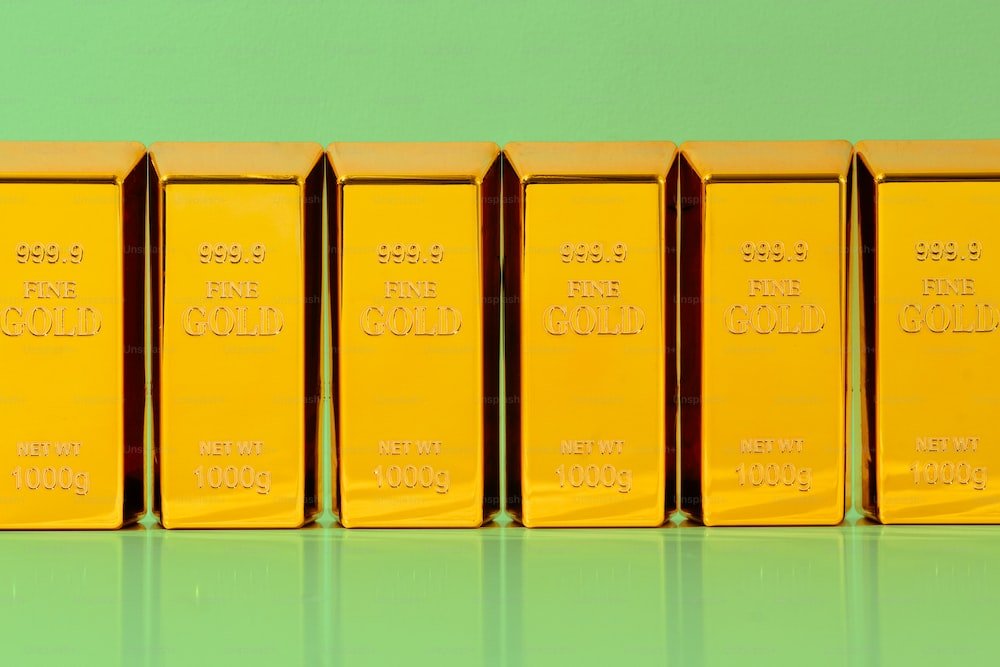Picture this: you work hard to save money and build your wealth over the years, only to see it slowly diminish in value due to inflation. It’s a silent killer that can erode the purchasing power of your savings without you even noticing. But fear not, there is a secret weapon in the world of investing that can help protect your hard-earned money: gold. In this article, we’ll explore why inflation can be detrimental to your savings and how gold can act as a safeguard against this wealth killer. So, grab a cup of coffee, sit back, and let’s dive into the fascinating world of inflation and gold.

This image is property of images.unsplash.com.
Understanding Inflation and Its Impact
Definition of inflation
Inflation is the sustained increase in the general price level of goods and services in an economy over time. It is measured by the inflation rate, which indicates the percentage change in the average price level over a specific period. When the rate of inflation is high, the purchasing power of money decreases, as it can buy fewer goods and services than before.
Causes of inflation
There are various causes of inflation, including:
-
Demand-pull inflation: This occurs when the demand for goods and services exceeds their supply, leading to higher prices.
-
Cost-push inflation: This happens when the cost of production increases, such as when wages or raw material prices rise, causing businesses to raise prices.
-
Monetary inflation: When there is excessive growth in the money supply, it can lead to inflation as the value of money decreases.
-
Built-in inflation: This occurs when expectations of future price increases lead to higher wages and prices in anticipation.
Effects of inflation on wealth
Inflation has a significant impact on wealth, affecting both individuals and businesses. Here are some of the effects:
-
Reduced purchasing power: As the cost of goods and services increases, the purchasing power of money declines. This means that you can buy fewer goods and services with the same amount of money.
-
Erosion of savings: If the interest rate on savings does not keep pace with inflation, the real value of savings decreases over time. This can be particularly detrimental for retirees or individuals saving for long-term goals.
-
Uncertainty and planning challenges: High inflation can create uncertainty in the economy, making it difficult for individuals and businesses to plan for the future. Price instability can disrupt investment decisions and hinder economic growth.
Historical examples of inflation
Throughout history, there have been several notable examples of inflation and its impact on economies. Two such examples include:
-
The Weimar Republic in Germany during the early 1920s experienced hyperinflation, where the value of the German mark plummeted and prices skyrocketed. This led to severe economic and social consequences, including widespread poverty and economic instability.
-
The United States experienced high inflation in the 1970s, known as the Great Inflation. During this period, inflation surged due to various factors, including rising oil prices and expansionary monetary policies. This period of inflation had a significant impact on the economy and led to changes in government policies and central bank strategies.
The Role of Gold as a Hedge Against Inflation
Introduction to gold as an investment
Gold has a long history as a store of value and a medium of exchange. As an investment, gold provides a hedge against inflation and helps protect wealth during periods of economic uncertainty. Investors buy gold as a way to preserve purchasing power and diversify their portfolios.
Historical performance of gold during inflationary periods
One of the reasons gold is often considered a hedge against inflation is its historical performance during inflationary periods. In the past, gold prices have tended to rise when inflation is high, as investors seek out safe-haven assets to protect their wealth. During periods of economic uncertainty, gold has often maintained its value or even appreciated, making it an attractive investment option.
Gold’s intrinsic value and market demand
Gold has inherent value due to its rarity and durability. Unlike fiat currencies, which can be created and devalued by central banks, the supply of gold is limited. This scarcity contributes to its desirability as a safe-haven asset during times of economic instability. Additionally, gold has industrial uses, further driving demand for the metal.
Correlation between gold prices and inflation
Numerous studies have demonstrated a positive correlation between gold prices and inflation. When inflation expectations rise, investors often allocate a portion of their portfolios to gold as a way to protect their wealth. As a result, the demand for gold increases, leading to upward pressure on prices.
Diversifying your portfolio with gold
Including gold in a diversified investment portfolio can help to mitigate risk and preserve wealth. Gold has historically exhibited low or negative correlation with other asset classes, such as stocks and bonds. This means that when other investments may be declining in value, gold could potentially provide a buffer and help offset losses.

This image is property of images.unsplash.com.
Understanding the Relationship Between Inflation and Purchasing Power
How inflation erodes purchasing power
Inflation erodes purchasing power by causing a decrease in the value of money. As the cost of goods and services increases, the same amount of money can purchase fewer goods and services. This means that over time, the value of money decreases, and individuals need to spend more to maintain the same standard of living.
Importance of maintaining purchasing power
Maintaining purchasing power is crucial to ensure long-term financial stability. By taking steps to protect your wealth from inflation, you can preserve the value of your savings and investments. This is especially important for individuals who rely on their savings or investments for income during retirement.
The role of gold in preserving purchasing power
Gold has a long history of preserving purchasing power over time. Unlike fiat currencies, which can be devalued through excessive money printing, gold’s value is not directly tied to any particular government or currency. As such, gold can serve as a hedge against inflation, allowing individuals to protect the purchasing power of their wealth.
Gold as a Safe Haven Asset
Characteristics of a safe haven asset
Safe haven assets are investments that tend to retain or increase their value during times of market volatility or economic uncertainty. They are often sought after by investors as a means of preserving wealth and reducing risk. The characteristics of a safe haven asset include:
-
Stability: Safe haven assets typically exhibit relatively stable prices or values compared to other investments.
-
Liquidity: These assets can be readily bought or sold without negatively impacting their market price.
-
Diversification: Safe haven assets have low or negative correlation with other types of investments, reducing the overall risk in a portfolio.
-
Perceived value: Investors view safe haven assets as having intrinsic value, providing a sense of security.
Gold’s historical role as a safe haven asset
Gold has long been regarded as a safe haven asset due to its historical role as a store of value. During times of political or economic turmoil, investors often turn to gold as a way to protect their wealth. This has been true throughout history, with gold retaining its value or even appreciating during periods of crisis or uncertainty.
Factors that contribute to gold’s safe haven status
Several factors contribute to gold’s status as a safe haven asset:
-
Limited supply: The scarcity of gold helps to maintain its value, as there is a finite amount of the metal available.
-
Global recognition: Gold is universally recognized as a valuable asset, providing liquidity and ease of trading in various markets worldwide.
-
Psychological factors: Gold has traditionally been associated with wealth and stability, leading investors to view it as a safe investment during uncertain times.
Comparing gold to other safe haven assets
While there are other safe haven assets, such as government bonds or certain currencies, gold offers unique advantages. Unlike bonds, which carry interest rate risk, gold is not tied to any specific currency or government. Additionally, gold has historically maintained its value better than currencies during periods of hyperinflation or economic instability.

This image is property of images.unsplash.com.
Investment Strategies: Allocating Gold in Your Portfolio
Determining an appropriate allocation to gold
The appropriate allocation to gold in a portfolio depends on several factors, including an individual’s financial goals, risk tolerance, and investment time horizon. There is no one-size-fits-all approach, but financial advisors often recommend allocating around 5-10% of one’s portfolio to gold as a diversified and defensive measure.
Factors to consider when investing in gold
When investing in gold, it is essential to consider the following factors:
-
Investment objective: Determine whether you are investing in gold for capital appreciation, wealth preservation, or as a hedge against inflation.
-
Investment horizon: Consider your investment time frame, as gold can be subject to short-term price fluctuations but has historically maintained its value over the long term.
-
Risk tolerance: Assess your tolerance for volatility and the potential for short-term price fluctuations in gold prices.
Different forms of gold investment
There are several ways to invest in gold, including:
-
Physical gold: This includes gold bars, coins, and jewelry. Owning physical gold provides direct ownership of the metal but comes with considerations such as storage and security.
-
Gold ETFs: Exchange-traded funds (ETFs) are investment funds that track the price of gold. Investing in gold ETFs provides exposure to the price of gold without the need to physically own the metal.
-
Gold mining stocks: Investing in gold mining companies can offer exposure to the gold industry and potential leverage to gold prices. However, mining stocks carry additional risks associated with company-specific factors.
The pros and cons of gold ETFs
Gold ETFs offer several advantages, including:
-
Diversification: Gold ETFs provide exposure to the price of gold without the need for physical ownership, allowing for easy diversification within a portfolio.
-
Liquidity: ETFs can be bought and sold on stock exchanges, offering greater liquidity compared to physical gold.
However, there are also potential drawbacks to consider, such as:
-
Counterparty risk: Gold ETFs are subject to the counterparty risk of the financial institution that issues the ETF.
-
Tracking error: Some ETFs may not perfectly track the price of gold due to management fees and other factors, leading to a discrepancy between expected and actual returns.
Owning physical gold vs. paper gold
The choice between owning physical gold or investing in paper gold, such as ETFs, depends on individual preferences and investment goals. Physical gold offers the advantage of direct ownership and the ability to hold a tangible asset. However, it also requires storage and security considerations. Paper gold, such as gold ETFs, offers convenience and ease of trading without the need for physical storage but carries counterparty risk.
The Importance of Timing in Gold Investments
Understanding market cycles and gold prices
Gold prices can be influenced by various market cycles, including economic, interest rate, and geopolitical cycles. Understanding these cycles can help investors identify potential opportunities for investing in gold. For example, during periods of economic uncertainty or inflationary pressure, gold prices tend to rise as investors seek out safe-haven assets.
Indicators for determining the right time to invest in gold
While timing the market perfectly is challenging, some indicators can help investors make informed decisions when investing in gold. These indicators include:
-
Inflation expectations: Rising inflation expectations often correlate with higher gold prices, as investors view gold as a hedge against purchasing power erosion.
-
Interest rates: Lower interest rates tend to benefit gold prices, as they reduce the opportunity cost of holding non-interest-bearing assets like gold.
-
Geopolitical events: Political instability or global economic uncertainties can drive investors toward safe-haven assets like gold.
Considering external economic factors
External economic factors, such as changes in supply and demand dynamics or shifts in global economic conditions, can impact gold prices. For example, increased gold production or a decline in jewelry demand may put downward pressure on gold prices. Conversely, factors like central bank policies, inflationary pressures, or currency depreciation can drive up gold prices.
Long-term vs. short-term investment strategies
When investing in gold, it’s crucial to consider whether you have a long-term or short-term investment strategy. Long-term investors focus on the overall trend in gold prices over several years, aiming to benefit from potential appreciation. Conversely, short-term traders may rely on technical analysis and market sentiment to make short-term trades, aiming to capture short-term price movements.
Practical Tips for Investing in Gold
Researching reputable gold dealers and custodians
When investing in physical gold, it is essential to research and choose reputable gold dealers and custodians. Look for dealers with a long-standing reputation and positive customer reviews. Consider factors such as storage facilities, security measures, and fees when selecting a custodian for storing physical gold.
Beware of gold investment scams
Gold investment scams can be prevalent, particularly during periods of economic uncertainty or rising gold prices. Be cautious of promises of guaranteed returns, unsolicited offers, and high-pressure sales tactics. Always research and verify the legitimacy of any investment opportunity before committing any funds.
Storing and securing physical gold
If you choose to own physical gold, it is crucial to store and secure it properly. Consider options like safe deposit boxes, home safes, or third-party storage facilities that specialize in storing precious metals. Implement security measures such as alarm systems, insurance coverage, and limited access to protect your investment.
Tax considerations for gold investments
The tax treatment of gold investments varies depending on your country of residence. Consult with a tax professional or financial advisor to understand the tax implications of buying, selling, or holding gold. Tax considerations may include capital gains tax, wealth tax, or reporting requirements for certain types of gold investments.
Regularly reviewing and rebalancing your gold portfolio
Investors should regularly review their gold portfolio and rebalance as needed to ensure it aligns with their investment strategy and goals. Market conditions, macroeconomic factors, and changes in personal circumstances may warrant adjustments to your allocation to gold or other investments.
Gold vs. Other Inflation Hedging Strategies
Comparing gold to other tangible assets
Gold is often compared to other tangible assets as an inflation hedge, such as real estate or commodities. While each asset has its own characteristics and benefits, gold offers unique advantages. Unlike real estate, gold is highly liquid and can be easily bought or sold. Additionally, gold’s scarcity and historical track record as a store of value make it an attractive option for preserving wealth.
The drawbacks of real estate as an inflation hedge
While real estate can be an effective inflation hedge, it also has drawbacks. Real estate investments typically require large capital investments and can be less liquid than gold. Additionally, real estate values can be affected by factors such as location, market conditions, and changes in interest rates.
Stocks and bonds as potential inflation hedges
Stocks and bonds can also serve as potential inflation hedges, but they have different characteristics compared to gold. Stocks can offer potential capital appreciation and dividends, but they carry higher market risk and are subject to economic and company-specific factors. Bonds, particularly inflation-protected bonds, can provide income and maintain purchasing power in inflationary environments. However, bond prices are influenced by interest rate changes.
The advantages and disadvantages of cryptocurrencies
Cryptocurrencies, such as Bitcoin, have emerged as another potential inflation hedge. While cryptocurrencies offer certain advantages, including decentralized control and potential anonymity, they also come with risks. Cryptocurrencies can be highly volatile, lack regulation, and may not have the same long-term track record as gold. Furthermore, the value of cryptocurrencies can be influenced by factors unrelated to inflation, such as technological developments or investor sentiment.
Case Studies: How Gold Preserved Wealth During Inflationary Periods
The Great Inflation in the 1970s
During the Great Inflation in the 1970s, gold proved to be an effective hedge against inflation. As inflation soared, the value of gold significantly increased, providing investors with the opportunity to preserve their purchasing power. This period highlighted gold’s ability to protect wealth during inflationary environments.
Hyperinflation in Zimbabwe
In Zimbabwe in the late 2000s, hyperinflation reached staggering levels, with prices doubling multiple times a day. Throughout this period, gold maintained its value as the local currency rapidly devalued. Many Zimbabweans turned to gold as a way to protect their savings and preserve their wealth.
The Venezuelan economic crisis
Venezuela has been facing a severe economic crisis characterized by hyperinflation and economic instability. Gold has played a vital role in preserving wealth in the country, as many individuals have turned to gold as an alternative currency and store of value. Despite the challenging economic conditions, gold has maintained its purchasing power.
Lessons learned from past inflationary periods
Past inflationary periods provide valuable lessons for investors. These periods have highlighted the importance of diversifying investments and incorporating assets like gold, which have a history of preserving wealth during times of inflation. By considering historical examples and staying informed, investors can make more informed decisions to protect their savings from the erosive effects of inflation.
Conclusion
Inflation can silently erode the wealth of individuals and businesses, making it essential to take steps to protect savings from its impact. Gold has long been recognized as a hedge against inflation, offering a way to preserve purchasing power and diversify investment portfolios. Whether through physical ownership, gold ETFs, or other investment vehicles, incorporating gold into an investment strategy can help protect wealth during uncertain economic times. By understanding the relationship between inflation and purchasing power and considering various investment strategies, individuals can safeguard their savings and potentially benefit from the long-term value of gold.



